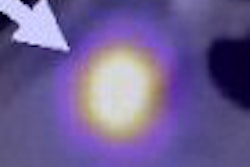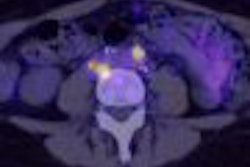In a prospective, randomized trial conducted at 18 sites internationally, MR first-pass myocardial perfusion imaging (perfusion-CMR) was at least equivalent to SPECT for detecting coronary artery stenosis, according to a new report in the European Heart Journal.
Perfusion MR has emerged as a sensitive test for detecting ischemia, and has been shown to perform well against CT angiography for detecting coronary artery disease. In a single-center study, the modality also compared favorably to cardiac SPECT, according to principal investigator Dr. Juerg Schwitter and colleagues from University Hospital Zurich in Switzerland and 17 other heart centers in Europe and the U.S.
"In particular, the high spatial resolution of perfusion-CMR allows detection of small, even subendocardial perfusion deficits," the group wrote. "In patients with acute chest pain, a normal perfusion-CMR study also had an excellent negative predictive value of 100% for subsequent diagnosis of CAD or an adverse outcome," they added (European Heart Journal, February 2008, Vol. 29:4, pp. 480-489).
However, perfusion-CMR has not been compared to other noninvasive diagnostic techniques in a large multicenter trial using equipment from different vendors. Therefore, as part of the Magnetic Resonance Imaging for Myocardial Perfusion Assessment in Coronary Artery Disease Trial (MR-IMPACT), the authors of the present study aimed to compare perfusion-CMR to quantitative x-ray angiography and SPECT for diagnosing coronary artery disease, defined as luminal narrowing of 50% or greater in two orthogonal planes at angiography.
The 241 eligible patients had undergone or were scheduled to undergo angiography and/ or SPECT, and for purposes of the study they also agreed to undergo perfusion-CMR.
Exclusion criteria included acute myocardial infarction within a week before enrollment, a history of coronary artery bypass surgery, unstable angina, decompensated heart failure, and any interventional procedure on the coronary arteries between the exams. Additionally, both angiography and SPECT had to be performed within four weeks of MR.
Perfusion-CMR was performed in 234 patients using five randomized contrast media doses (0.01, 0.025, 0.05, 0.075, or 0.1 mmol/kg Gd-DTPA-BMA (Omniscan, GE Healthcare, Chalfont St. Giles, U.K.) per stress (0.42 mg/kg adenosine) and rest perfusion study for detecting coronary artery disease (CAD). Quantitative angiography served as the reference standard, and the diagnostic performance of perfusion-CMR at the optimum contrast media dose was compared with SPECT imaging.
The researchers performed first-pass breathhold MRI on 18 1.5-tesla scanners from three different manufacturers. Three short-axis slices of 8-10 mm were acquired for each heartbeat at one-fourth, one-half, and three-fourths of the left ventricular long axis. The pulse sequences used a nonslice selective 90° preparation, saturation read-out delay time of approximately 120 msec, and read-out achieved with a fast gradient-echo sequence. Stress data were acquired three minutes after injection of adenosine, and a second injection was given 20 minutes after the study to enable a rest perfusion study, Schwitter and his team wrote.
Three experienced readers blinded to the results of other tests interpreted the data at an independent core laboratory, and receiver operator characteristics (ROC) analysis results were used to compare perfusion-CMR with SPECT.
Evaluable studies were analyzed for all tests in 225 patients (73% male). Thirteen of these patients (5.8%) had nonevaluable perfusion-CMR or SPECT exams. Seventy-seven percent had coronary artery disease, and 31% had undergone percutaneous interventions. No deaths and no adverse events occurred as a result of the procedures, Schwitter's group reported.
Perfusion-CMR at the optimal contrast dose (0.1 mmol/kg) had similar performance compared to SPECT when only the 42 patients who received this dose were considered in the analysis. The area under the curve (AUC) was 0.86 ± 0.06 for perfusion-CMR compared to 0.75 ± 0.09 for SPECT (p = 0.12).
However, when comparing perfusion-CMR to the entire SPECT population, the ROC analysis showed better performance for perfusion-CMR (n = 42, AUC: 0.86 ± 0.06) compared to SPECT (n = 212, AUC: 0.67 ± 0.5, p = 0.013 versus CMR). CMR's performance at the 0.1 mmol/kg contrast level was also superior in the population of patients with two or three vessel disease (n = 32 and 161 for CMR and SPECT, respectively; AUC 0.89 ± 0.6 versus 0.70 ± 0.05; p = 0.006).
"Early detection of myocardial perfusion abnormalities is crucial for an optimal management of patients with suspected CAD, and could potentially reduce the rate of fatal (myocardial infarctions)" the authors wrote. "In this prospective, randomized, multicenter study, a high diagnostic performance of perfusion-CMR for the detection of CAD in ≥ 2-mm coronary vessels was found at a (contrast media) dose of 0.1 mmol/kg, which was equal to SPECT in the head-to-head comparison."
At the 0.1 mmol/kg dose, perfusion-CMR's diagnostic performance was superior to that of SPECT when all 212 studies, gated and nongated combined, were compared, the authors noted. The current results across 18 centers are in line with previous studies in single centers, they added.
One limitation of the study was that SPECT was not available in approximately half of the patient cohort. Another limitation was that CMR did not outperform SPECT in coronary artery disease detection, but only in the ROC analysis. Apical segment 17 was not included in the analysis because the focus was on detecting stenosed vessels that were candidates for revascularization. As a result, larger multicenter trials will be needed to confirm the current results, the authors concluded.
The results suggest that perfusion-CMR at 0.1 mmol/kg is a valuable technique for coronary artery disease detection in vessels 2 mm and larger, and should be considered an alternative to SPECT in specialized centers, and for patients with known or suspected coronary artery disease, Schwitter and his colleagues wrote. The comparison of perfusion-CMR to SPECT across the entire SPECT population suggests CMR's superiority, which should be confirmed in larger trials.
By Eric Barnes
AuntMinnie.com staff writer
February 18, 2008
Related Reading
Women more likely than men to have subclinical aortic atherosclerosis, January 21, 2008
Dipyridamole stress cardiovascular MRI predicts CAD outcomes, October 11, 2007
Dobutamine CMR gauges cardiomyopathy treatment response, May 2, 2007
Cardiac MR measures predict pulmonary hypertension, April 9, 2007
Copyright © 2008 AuntMinnie.com



















